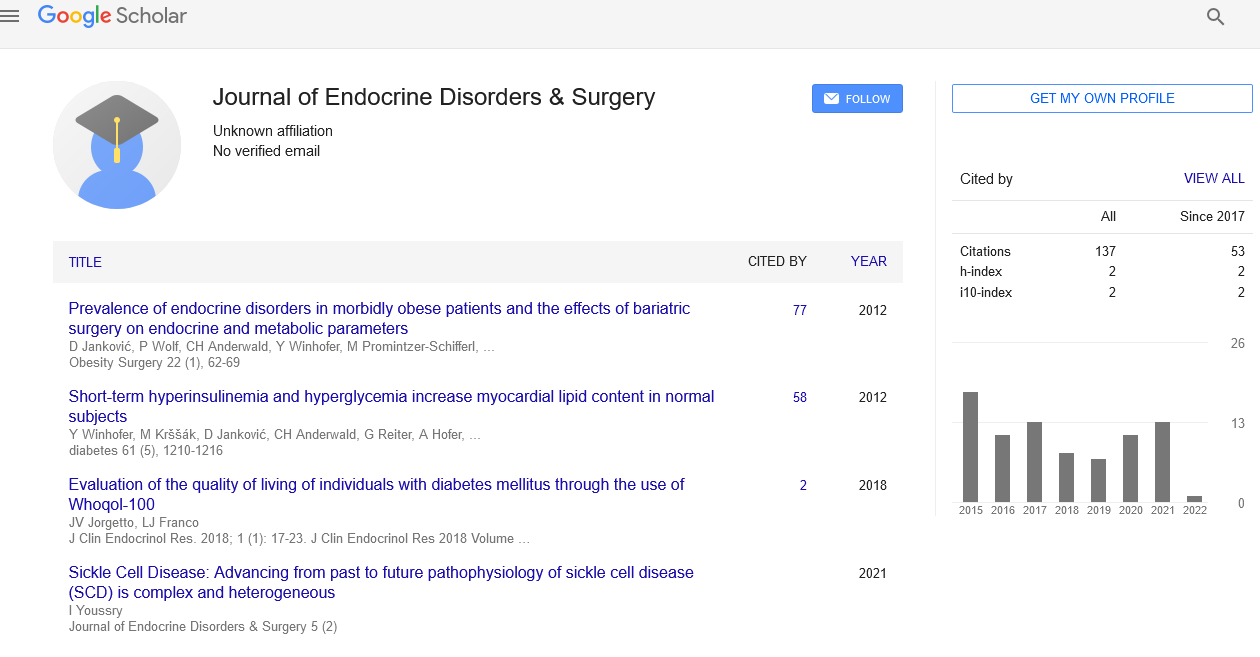
Sign up for email alert when new content gets added: Sign up
Author(s): John Philip Tarburton
The aim of this study was to assess the sensitivity of diabetics' blood to methemoglobinization compared to normal blood by ethyl nitrite and hexyl nitrite. Single factor ANOVA was calculated from the HbA1C values and the methemoglobinization times for ethyl nitrite and hexyl nitrite induced oxidations of 40 blood samples. A total of four groups were examined wherein n=20 for each group, i.e., group one consisted of ethyl nitrite treated type 2 diabetics blood; group two consisted of ethyl nitrite treated normal blood; group three consisted of hexyl nitrite treated type 2 diabetics blood; and group four consisted of hexyl nitrite treated normal blood. The blood samples used were identical for both of the nitrites employed in these studies. Thus for all the samples examined (n=80) an F value of 911.57 was calculated for these four groups which is greater than the F critical value of 2.73 so this means P<0.05. Post-hoc tests have revealed that the diabetics blood oxidation times differs significantly from normal blood (P<0.05). Data from all four groups (n=80) were used to get the best fit line Y=6.01-0.36X wherein X the independent variable=percent HbA1C and Y the dependent variable=methemoglobinization time in minutes. The standard error of estimate was 0.45 whereas the slope had an estimated standard error of 0.020. The coefficient of determination (r2) was found to be 0.86 which means that 86% of the total variation in y can be explained by the best fit line. This level of predictive acceptance is denoted as substantial. Because these nitrite esters differ only in the alkyl or R group attached to the ester this may well help to explain the high r2 value. In addition, this study demonstrates that a best fit line can be of good use to predict rates of hemoglobin oxidation times by these nitrite esters based solely on their HbA1C% value. It follows then that best fit lines based on empirical data are valuable tools to predict methemoglobinization time based just on HbA1C values for any alkyl nitrite.
Sigma-Aldrich Chemical Company was used as the supplier for ethyl nitrite. Fisher Scientific was the supplier used for hexyl nitrite and other needed chemicals (i.e., for solutions, solvents, cleaning, etc.) Adult blood samples were obtained from Physicians Plasma Alliance (PPA) which included 20 normal and 20 Type 2 diabetic blood samples. The procedures followed by PPA for this sample collection study were in accordance with the ethical standards of the Hummingbird IRB Protocol wherein all subjects used in these studies gave voluntary informed consent. These blood products were all tested and found to be negative for antibodies to HIV 1/2 and HCV and are certified to be non-viral by a FDA licensed testing facility. Acid-Citrate- Dextrose tubes were used for blood drawing and were stored at 2-4°C.
Quantitative measurement of HbA1C present in the blood samples was done with a Bayer DCA-2000 analyzer wherein HbA1C (%) ≥ 6.5 is classified as Diabetes Mellitus [22]. Measurement of methemoglobin formation was done with a Thermo Scientific Genesys 10S UV/VIS Spectrophotometer. Blood samples obtained from PPA were centrifuged for 20 min at 2000 g at ambient temperature to allow for removal of the plasma. The remaining packed cells were then aerated by vortexing and washed in phosphate buffer at pH 7.2. Centrifugation and washing were repeated twice more with the aforementioned buffer. The red cells were then resuspended in pH 7.2 phosphate buffer and stored for a maximum of 60 min prior to testing. Red cells in the suspension were lysed wherein 0.01 mL of them was added to 1.0 mL of distilled water. The final volume was adjusted to 2.6 mL by the addition of pH 7.2 phosphate buffer. An absorbance of A=1.0 ± 0.2 at λ=436 nm was ordinarily obtained which constituted the baseline oxyhemoglobin absorbency value range for these methemoglobinization experiments.
Ethyl nitrite (or hexyl nitrite) which had been diluted to strength of 0.1% in ethanol solution was prepared as a stock solution. A 0.05 mL aliquot of one of these stock solutions was then added to the aforementioned hemoglobin solution and was then placed in a cuvette. (Note: Ethyl nitrite=38 μM and hexyl nitrite=138 μM) and the final hemoglobin concentration was approximately 10 μM [23]). The Genesys spectrophotometer set at λ=436 nm has a built in chart recorder which generated an inverted S curve as the oxidation of oxyhemoglobin into methemoglobin reaction proceeded to completion. A final asymptotic phase which is indicative of 100% methemoglobin formation gave a final absorbency range of A=0.5 ± 0.1.
PDF





